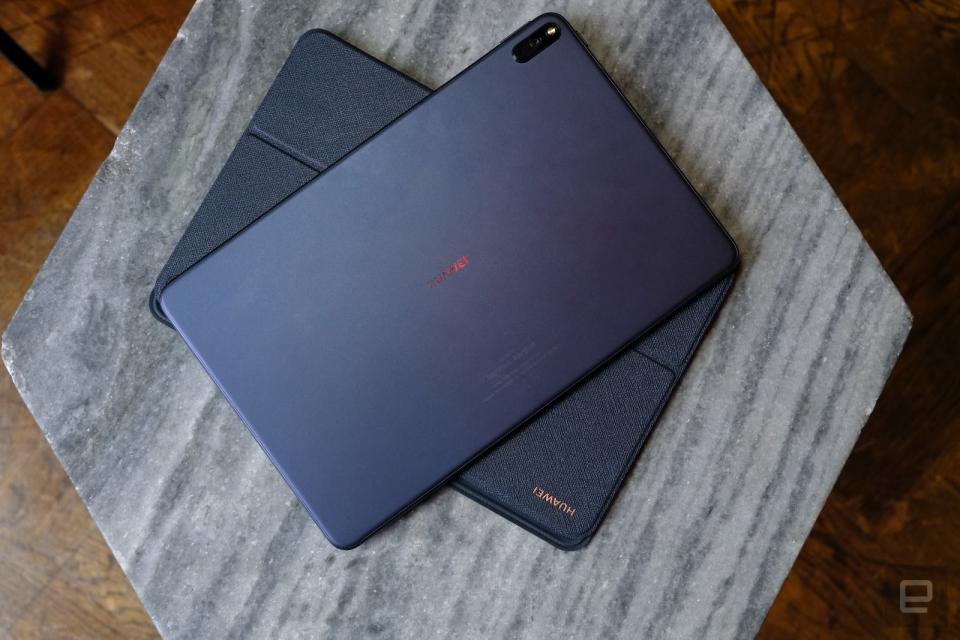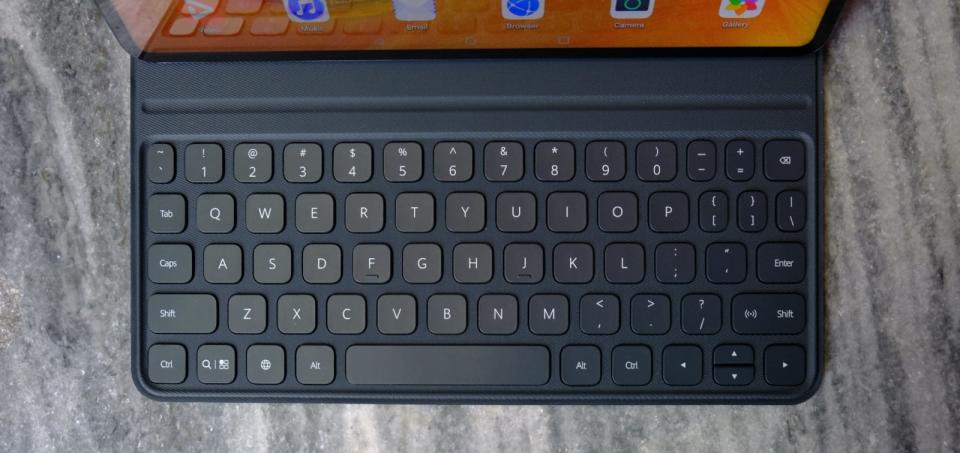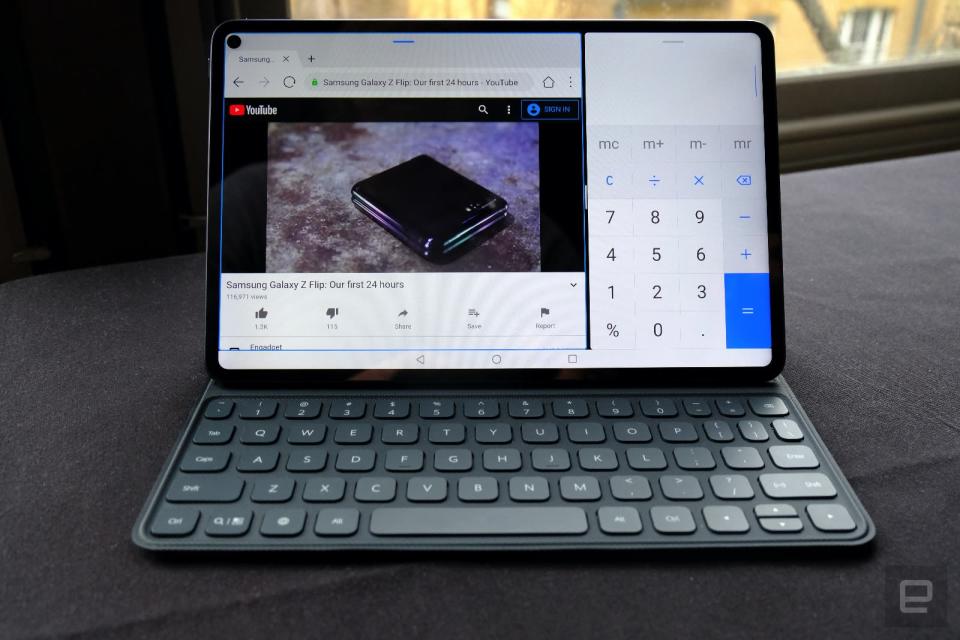Huawei’s 10.8-inch iPad Pro rival can wirelessly charge your phone
The MatePad Pro also has a folio keyboard and Huawei's take on the Apple Pencil.
Huawei's big MWC reveal that never was is the MatePad Pro, a stylish tablet that will come with a keyboard folio and companion stylus in an attempt to go toe-to-toe with the iPad Pro. It's the company's biggest attempt yet to establish a premium tablet range, having made middling and entry-level tablets for a while. Years, in fact.
As it did with its smartphones, though, the company has decided it's time to elevate its tablet efforts -- at a time when everything is either an iPad or a Windows 10 2-in-1. And you know what? Hardware-wise, Huawei may have completely nailed it.
Does the name sound familiar, right? That's probably because Huawei unveiled its MatePad Pro for China around the end of 2019, but with no news of taking it anywhere else. Now, it's apparently ready to do so with a 5G iteration, coming to... regions that Huawei is going to announce during its press conference later today.

For now, let's get back to cooing over the hardware. The MatePad Pro is a 10.8-inch tablet that, if it hasn't changed from its China iteration (we're still waiting on Huawei to confirm specs on this model), weighs 460 grams, like the similarly sized iPad Pro. It's got a gorgeous magnesium alloy frame with curved corners, and while I only saw the more standard colors (dark blue and white) in person, they're both stylish, premium tablets. There will be dark "forest green" and "afterglow orange" options, too, both with vegan leather back panels. Since the iPhone 11, I've been drawn to gadgets with a green hue, so I'm excited -- even if 'vegan leather' auto-translates in my brain to 'leatherette'.
The MatePad Pro's cellular and WiFi antennae are molded directly to the tablet frame, meaning no visible antenna lines. There's also an 8-megapixel hole-punch camera on the front (for conference calls more than selfies, I hope), which mirrors, location-wise, the rear-facing 13-megapixel camera. Hole-punch cameras are unusual for tablets, but has helped Huawei hone down those bezels.
With a 90 percent screen-to-body ratio, the MatePad Pro has a very thin bezel around the screen -- apparently 4.9mm. That's far smaller than the iPad Pro's border, which measures more than 8 mm. Now, I'm not sure I care much about that, but there's certainly some engineering bragging rights there, and if I haven't said it enough already, it helps elevate the looks of this thing, iPad baiting aside.
The screen itself is vivid and bright (up to 540 nits), with a 2,560 x 1,600 resolution -- high enough to split up tasks and apps on screen without making things tiny or blurry.
There's a 7,250mAh battery inside the tablet, but the most interesting spec here is the size and kinds of charging the MatePad Pro can handle. Fast-charging this time around can take in up to 40W, while Huawei has really amped up wireless charging, up to 27W if you have the appropriate wireless charger.
The tablet itself is a wireless charger, too, able to reverse-charge compatible phones at 7.5W -- what you typically get from most plug-in wireless chargers. The flat 10.8-inch slate makes for a far more viable charging surface than a phone of similar size -- it's a smarter place to include the feature. You might actually use it more often than you do on your Samsung or Huawei phone.
Other things you might want to slap on to the MatePad Pro? A companion keyboard folio, sold separately, or perhaps the M-Pencil stylus, also sold separately.
First, the folio, which feels like the iPad Pro's own keyboard accessory -- and that's a good thing. I'll withhold judgment on how well extended typing sessions might feel, but early impressions are good. It passively powers itself from the tab. The so-called Smart Keyboard will set you back €129 (around $140).

The M-Pencil is more interesting. The peripheral is definitely the arch-nemesis of the Apple Pencil, but has a cute hexagonal design, like a Staedler pencil. It magnetically attaches to the MatePad Pro and wirelessly charges itself, too. Half a minute of charge equates to 10 minutes of use, and you can expect 10 hours of scribbling on a full charge. The M-Pencil will cost €99 (around $107).
Together, these accessories pitch the MatePad Pro as a more thought-out tablet, one aimed at productivity, whether that means typing words or sketching plans. It also makes it way more interesting than any tablet Huawei's made before.
When it comes to the software, a new 'app multiplier' feature is the stand-out idea, allowing you to run two versions of several core apps, including the web browser, in a landscape arrangement.
You can adjust the proportion of screen dedicated to each app iteration, though it's pretty buggy at this demo stage. Sometimes I had to close apps to get the arrangement of apps I wanted -- there's a knack to it all.
If you're feeling particularly masochistic, you can even throw in a floating third window for calculations or other functions, though, oddly, there's no floating notepad. That aside, it helps reinforce the multitasking 'pro' vibe that Huawei is going for with its new tablet.
Like Huawei's updated foldable, the MatePad Pro packs the company's own Kirin 990 processor, which includes the modem needed for a 5G connection. It means there's plenty of processing power, even if, in these days of no Google Play, there really isn't much of note to push Huawei mobile devices to their limits.

So about that app problem. The company says there are now over 1,000 apps supported on its devices, but spokespeople wouldn't be drawn to announcing the whereabouts of go-to mobile apps like Uber, still missing on Huawei devices. If an app isn't on the device's own app store, it means delving into the world of Amazon app stores, sideloading and other stuff that a lot of us (power-users aside, I know you're reading this) can't be bothered to do. Google also advises against it, for security and safety reasons.
Huawei still hasn't nailed the move from Android 10 (as you know it) to AOSP (Android Open Source Project). It's been historically hard for Android tablets to go toe-to-toe with the iPad. For the MatePad Pro, it's going to be even harder.
If this is a creativity or productivity tablet then the optional extras can turn the MatePad Pro into an impressive mobile work machine. If you want to consume media, play games, do stuff beyond web browsing, the MatePad Pro doesn't look like it can satisfy those urges. I'll wait for a review sample -- and a price -- to change my mind.
The MatePad Pro will start at €549 (around $594) for a WiFi version with 6GB RAM and 128GB of storage. If you want the M-Pencil included, you'll have to pay and extra €200 for the 8GB RAM and 256GB storage WiFi model (€749 or around $810). Both of those configurations are available with LTE (no M-Pencil) for €599 (around $648) and €699 (around $756) respectively. Huawei says these WiFi versions of the tablet will be available in April. There's also a 5G version that will start at €799 (around $865), but there's no word on availability for it just yet.

